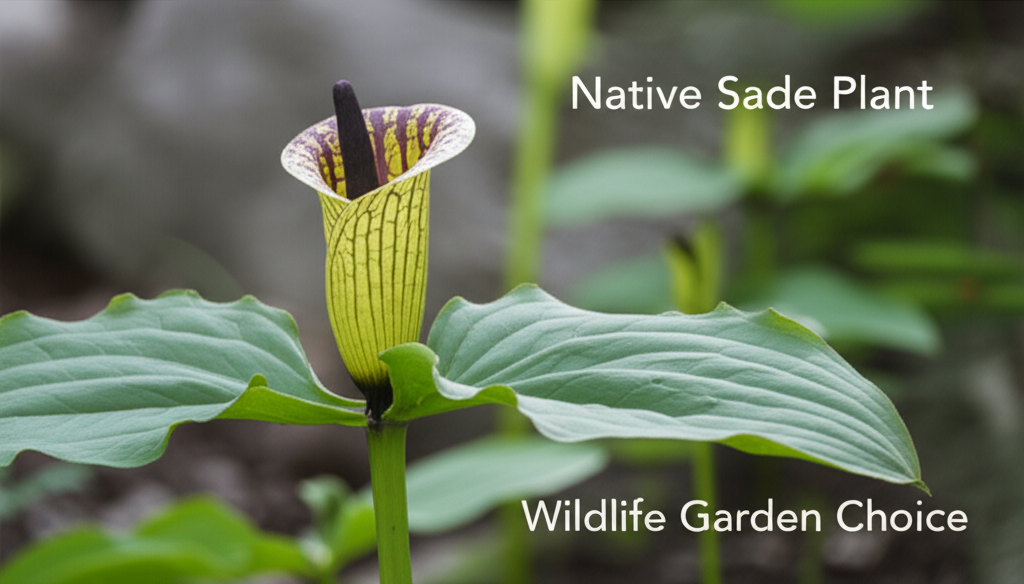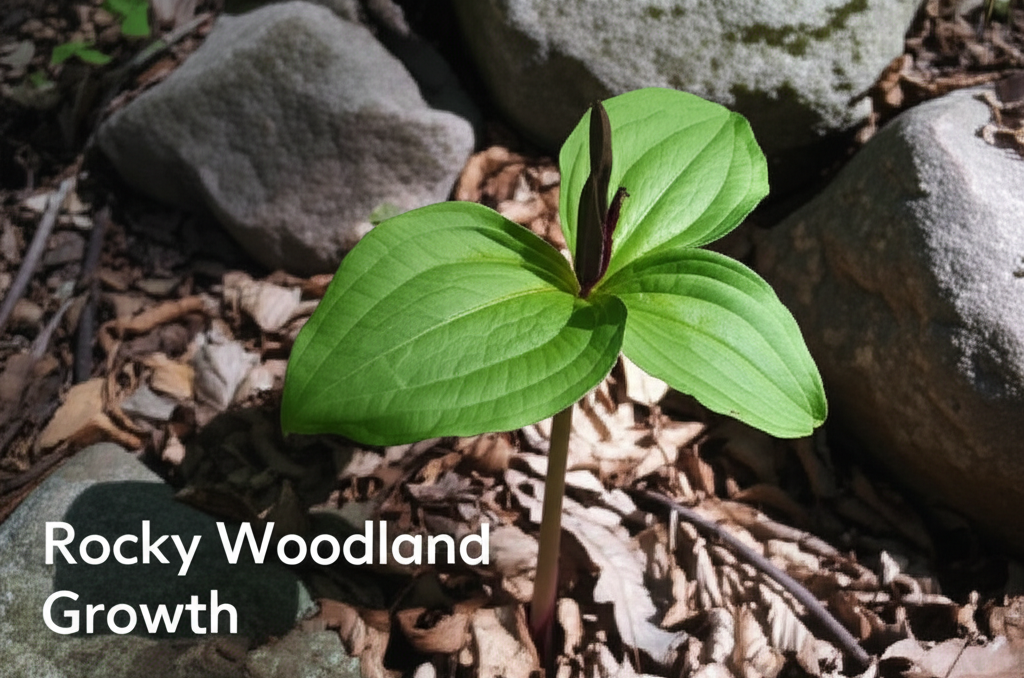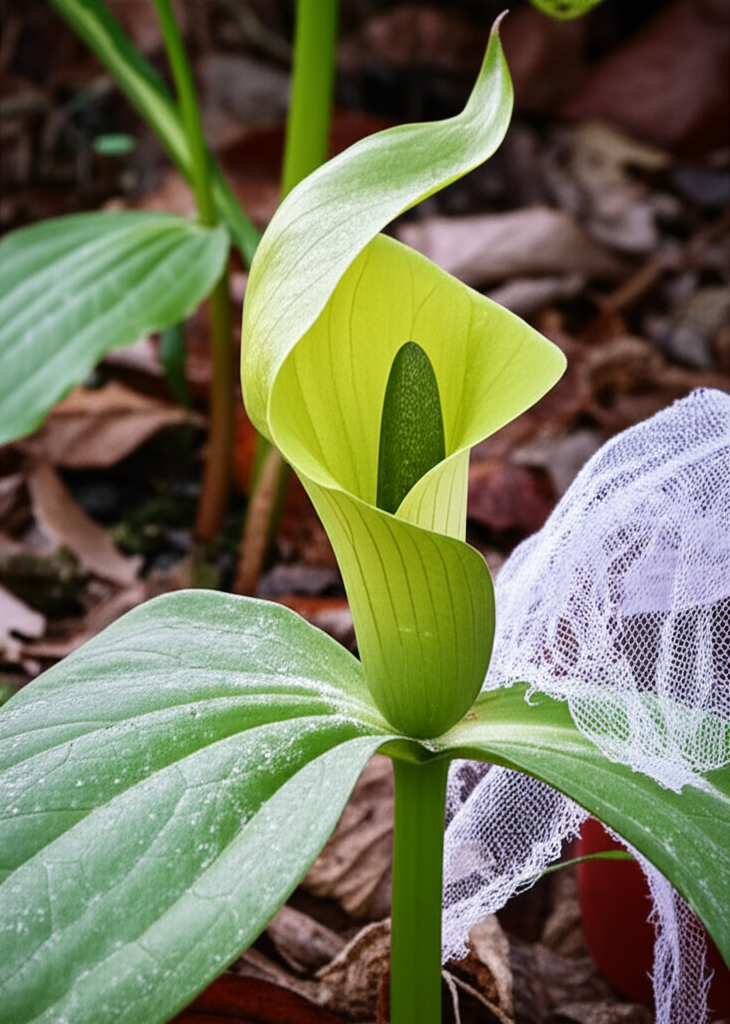Transform Your Garden with the Intriguing Jack-in-the-Pulpit
The Jack-in-the-Pulpit (Arisaema triphyllum) is a truly fascinating native wildflower that offers a unique blend of ecological value and captivating visual appeal for any garden. Often found gracing the shaded, moist understories of woodlands, this distinctive plant is more than just a botanical curiosity; it’s a vital resource for a surprising array of wildlife, contributing to a healthier and more vibrant ecosystem within your own backyard. Its unusual “Jack” emerging from its “pulpit” structure makes it a conversation starter, while its ecological benefits make it a star player for the wildlife-conscious gardener. This article will delve into the many reasons why incorporating Jack-in-the-Pulpit into your garden design is a decision that benefits both you and the natural world.
Understanding the Jack-in-the-Pulpit: Botany and Bloom

Before we explore its role in the garden, it’s essential to understand what makes the Jack-in-the-Pulpit so special botanically. This herbaceous perennial is a member of the Araceae family, which also includes well-known plants like calla lilies and peace lilies, explaining its somewhat exotic appearance. Its common name, Jack-in-the-Pulpit, refers to its distinctive inflorescence. This structure consists of a spathe (a modified leaf) that enfolds a spadix (a fleshy spike bearing the tiny flowers). The spathe, often green with purplish or brown stripes, curls over to form a hood, resembling a pulpit, with the spadix – the “Jack” – standing upright within. This unique formation is not just for show; it serves a crucial function in attracting pollinators.
Pollination and Reproduction
The spathe’s distinctive shape and often sweet, decaying scent at maturity are designed to attract specific pollinators, primarily fungus gnats and other small flies that are drawn to damp, decaying organic matter. These insects crawl into the spathe, seeking what they believe to be a food source or a suitable place to lay eggs. The spadix is covered in a fine, downward-pointing hair-like structure called a spadix appendage, which, once the insect enters, effectively traps it within the spathe. This ensures that the tiny flowers clustered at the base of the spadix are pollinated. After pollination, the plant develops a cluster of bright red berries in the late summer or fall.
Life Cycle and Dormancy
Jack-in-the-Pulpit typically emerges in early spring, often pushing through leaf litter even before many other woodland plants. The leaves, usually a trifoliate arrangement of three leaflets, unfurl shortly after the spathe. The plant is dioecious, meaning individual plants are either male or female, though many can change sex throughout their lives depending on environmental conditions and their size. The flowers are wind-pollinated, but the insects trapped within the spathe are key to ensuring that pollen reaches the female flowers. After the berries have dispersed, the plant enters dormancy, its foliage dying back to the ground, and it remains underground as a corm throughout the winter.
Why Choose Jack-in-the-Pulpit for Your Wildlife Garden?
The inclusion of native plants is a cornerstone of any successful wildlife garden, and Jack-in-the-Pulpit excels in this regard. Its contributions to the local ecosystem are multifaceted, providing food, shelter, and supporting essential ecological processes.
Food Source for Wildlife
While the plant itself is poisonous to humans and many animals in its raw state due to the presence of calcium oxalate crystals, the mature berries are a valuable food source for various birds. Species like thrushes, robins, and bluebirds will consume the bright red berries after the initial toxicity has been mitigated by frost or decomposition. The plant’s underground corms, while toxic when fresh, can be processed (by soaking, drying, and cooking) to remove the oxalates, making them edible. Historically, indigenous peoples utilized these corms as a food source, demonstrating the plant’s nutritional potential when prepared correctly. Even without direct consumption by larger animals, the presence of the plant supports the insect populations that are, in turn, food for birds and other insectivores.
Pollinator Attraction
As mentioned, the intricate pollination mechanism of Jack-in-the-Pulpit attracts a specific suite of beneficial insects. While not typically considered a nectar plant for bees or butterflies, it provides a habitat and breeding ground for many small flies and gnats, which form a critical part of the food web. Supporting these smaller creatures indirectly benefits insectivorous birds and amphibians that rely on them for sustenance. The flowers themselves, though small, contribute to the overall biodiversity of your garden’s insect life.
Habitat and Shelter
The broad leaves of the Jack-in-the-Pulpit provide excellent ground cover and habitat for various small woodland creatures. During the spring and summer, the dense foliage offers protection from predators and the elements for insects, amphibians like salamanders, and potentially small rodents. The leaf litter that accumulates around the base of the plant also creates a microhabitat for decomposers and beneficial soil organisms, contributing to healthy soil structure and nutrient cycling.
Cultivating Jack-in-the-Pulpit: A Guide to Success
Growing Jack-in-the-Pulpit successfully is achievable even for novice gardeners, provided you understand its specific needs. Mimicking its natural woodland environment is key.
Ideal Growing Conditions
Light: Jack-in-the-Pulpit thrives in partial to full shade. It prefers dappled sunlight filtering through a tree canopy or the north side of a building. Direct, harsh sunlight, especially in the afternoon, can scorch its leaves.
Soil: Rich, moist, and well-draining soil is crucial. A loamy soil amended with plenty of organic matter, such as compost or leaf mold, will provide the nutrients and moisture retention the plant requires. Avoid heavy clay soils that can become waterlogged.
Moisture: Consistent moisture is vital, especially during the growing season. While it enjoys damp conditions, it does not tolerate standing water. Ensuring good drainage while keeping the soil consistently moist will prevent both drying out and root rot.
pH: A slightly acidic to neutral soil pH (around 5.5 to 7.0) is generally preferred.
Planting and Propagation
Jack-in-the-Pulpit is best planted from corms. These should be planted in the fall, about 3-4 inches deep, with the growing point facing upwards. Space them about 6-8 inches apart to allow for their mature spread. Propagation can also be achieved by seed, though this is a much slower process, with germination often taking several years. Division of established corms is also a viable method for propagation, best done in late fall after the foliage has died back.
Companion Planting
To further enhance the wildlife-friendly aspect and aesthetic appeal of your Jack-in-the-Pulpit planting, consider companion planting with other shade-loving native wildflowers that share similar growing requirements. Excellent choices include:
- Foamflower (Tiarella cordifolia)
- Wild Ginger (Asarum canadense)
- Trillium (various species)
- Ostrich Fern (Matteuccia struthiopteris)
- Woodland Phlox (Phlox divaricata)
These plants will create a beautiful, layered woodland scene that provides continuous blooms and habitat throughout the seasons.
Jack-in-the-Pulpit in the Wildlife Garden: A Summary of Benefits and Considerations
Incorporating Jack-in-the-Pulpit into your garden design offers a compelling array of benefits for supporting local wildlife and enhancing your garden’s ecological function. Its unique appearance, ecological contributions, and relatively straightforward care requirements make it an exceptional choice for gardeners looking to create a more biodiverse and engaging outdoor space.
| Feature | Description | Wildlife Benefit |
|---|---|---|
| Botanical Name | Arisaema triphyllum | Native status supports local ecosystems. |
| Light Requirements | Partial to full shade (dappled sunlight ideal) | Mimics natural woodland habitat, benefiting shade-loving flora and fauna. |
| Soil Preferences | Rich, moist, well-draining, organic-rich soil | Supports healthy soil microbes and provides a stable environment for plant growth. |
| Bloom Time | Spring (April-May) | Provides early-season nectar and pollen for specific insect pollinators. |
| Fruit | Bright red berries in late summer/fall | Food source for birds after frost or decomposition. |
| Toxicity | Contains calcium oxalate crystals (raw plant) | Discourages consumption by most larger mammals, protecting the plant. |
| Habitat Value | Provides ground cover and shelter | Offers protection for insects, amphibians, and small soil dwellers. |
Steps to Establishing a Jack-in-the-Pulpit Planting
Creating a successful patch of Jack-in-the-Pulpit involves understanding its lifecycle and providing the right conditions. Follow these steps for optimal results:
- Site Selection: Identify a shady or partially shaded area in your garden that receives dappled sunlight. Ensure the location has rich, well-draining soil that can retain moisture. Consider areas under deciduous trees or on the north side of structures.
- Soil Preparation: Amend the soil generously with organic matter such as compost, leaf mold, or well-rotted manure. This will improve soil structure, fertility, and moisture-holding capacity. A slight acidity is beneficial.
- Planting Corms: The best time to plant Jack-in-the-Pulpit corms is in the fall, before the ground freezes. Plant them approximately 3-4 inches deep, with the pointed (growing) end facing upwards. Space them 6-8 inches apart to allow for growth and spread.
- Watering: Water the newly planted corms thoroughly. During the growing season (spring and summer), maintain consistent moisture, watering whenever the top inch of soil begins to dry out. Avoid overwatering, which can lead to rot.
- Mulching: Apply a layer of organic mulch, such as shredded bark, leaf mold, or compost, around the base of the plants. This helps retain soil moisture, suppress weeds, and regulate soil temperature.
- Patience: Jack-in-the-Pulpit can sometimes take a season or two to establish and begin flowering reliably. Be patient and allow the plants to settle into their new environment.
- Observation: Observe your plants for signs of pests or diseases, though they are generally quite robust. Monitor the wildlife that visits your planting, noting birds that may feed on the berries and insects attracted to the flowers.
Pros and Cons of Growing Jack-in-the-Pulpit
While Jack-in-the-Pulpit offers significant advantages for wildlife gardens, like any plant, it has certain considerations.
| Pros | Cons |
|---|---|
| Unique Aesthetic Appeal: Its distinctive spathe and spadix create a striking visual focal point. | Slow to Establish: Can take a year or two to reach mature size and flowering potential. |
| Excellent for Wildlife: Supports specialized insect pollinators and provides food for birds (berries). | Toxicity: Raw plant contains calcium oxalate crystals, making it unsafe for human or pet consumption without proper processing. |
| Native Plant: Well-adapted to local conditions and supports native ecosystems. | Specific Needs: Requires consistent moisture and shade, which may not suit all garden locations. |
| Low Maintenance (once established): Generally pest and disease resistant and requires minimal care. | Can Spread: May spread subtly through rhizomes, which can be a pro for naturalizing but a con if space is very limited. |
| Deer and Rabbit Resistant: The toxicity of the plant deters most common garden pests like deer and rabbits. | Not for Sun-Loving Gardens: Will not thrive in full sun or dry conditions. |
Conclusion: A Woodland Wonder for a Thriving Garden
The Jack-in-the-Pulpit is a testament to the subtle yet profound ways in which native plants contribute to a healthy ecosystem. By providing its preferred habitat of shade, moisture, and rich soil, you are not only cultivating a visually captivating specimen but also actively supporting a delicate web of life. From its specialized pollinators to the birds that feast on its late-season berries, this woodland gem offers a multitude of benefits that align perfectly with the goals of any wildlife-friendly garden. Embrace the intrigue and ecological value of the Jack-in-the-Pulpit and watch your garden transform into a miniature woodland haven, teeming with life and natural wonder.


